Soft Fork
A change that is compatible with old software
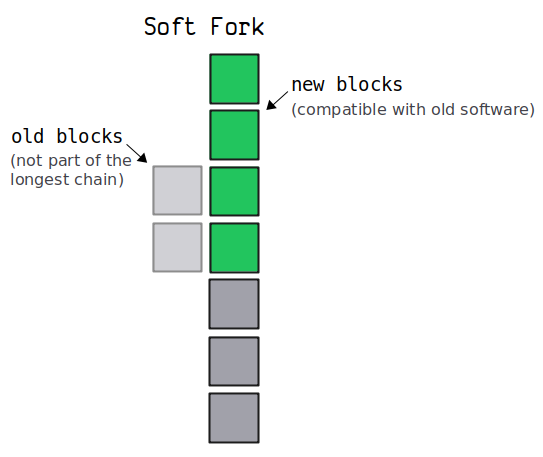
A soft fork is when an upgrade is made to the Bitcoin software that is compatible with the previous versions of the software.
To summarise the difference between a soft fork and a hard fork:
- A hard fork expands the rules on what makes a valid block/transaction.
- A soft fork restricts the rules on what makes a valid block/transaction.
With a soft fork, nodes that do not upgrade their software will still be able to accept blocks/transactions created by the upgraded software. Therefore, nodes that do not upgrade will be able to keep up to date with the blockchain and not get left behind.
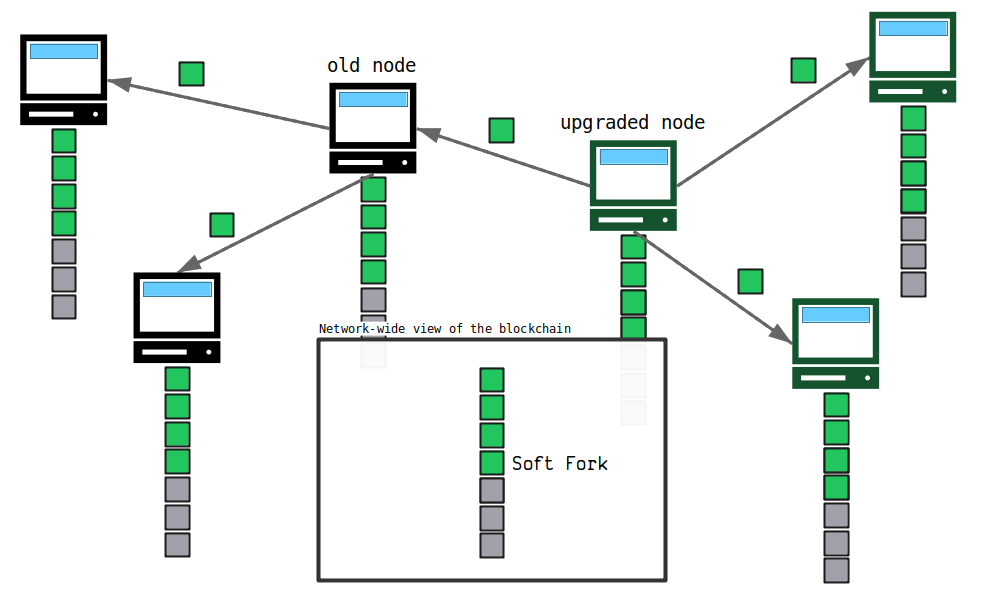
To make a soft-forking change successful, you only need a majority of the miners on the network to upgrade to the new version of the software. Because if you have a majority of miners upgrade, their mining power will build the longest chain of upgraded blocks (which the old nodes will adopt).
Scenario
How do you create a soft fork?
To create a soft fork, you need to restrict the rules on what is considered a valid block or transaction.
In other words, you need to make previously valid blocks/transactions invalid.
For example, let's say the block size limit is 1 MB (block capacity is now measured in weight, but don't worry about that for now). A soft-forking change would be to create a new rule that restricts the block size to 0.5 MB instead (sounds like a step backwards, I know, but this is just an example).
When upgraded miners begin to mine these smaller blocks, old nodes will still see these new blocks as valid, so there will be no branching of the blockchain like there would be in a hard fork.
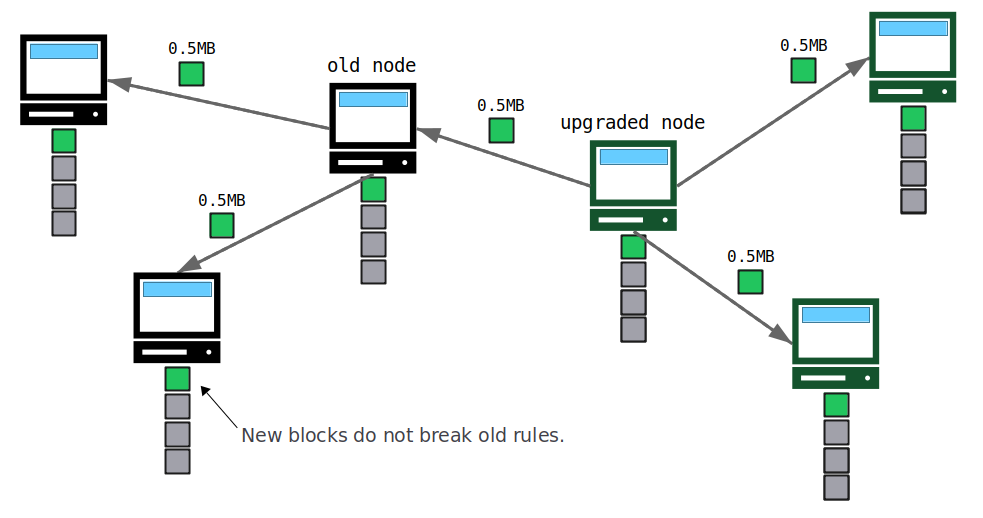
Method
How do you make a soft fork successful?
To make a soft fork successful, you want a majority of miners to upgrade to the new version of the software.
This is because nodes will always accept the longest chain of blocks, so if the majority of miners are working on mining the upgraded blocks with the restricted rules, the old nodes will naturally adopt it as their blockchain.
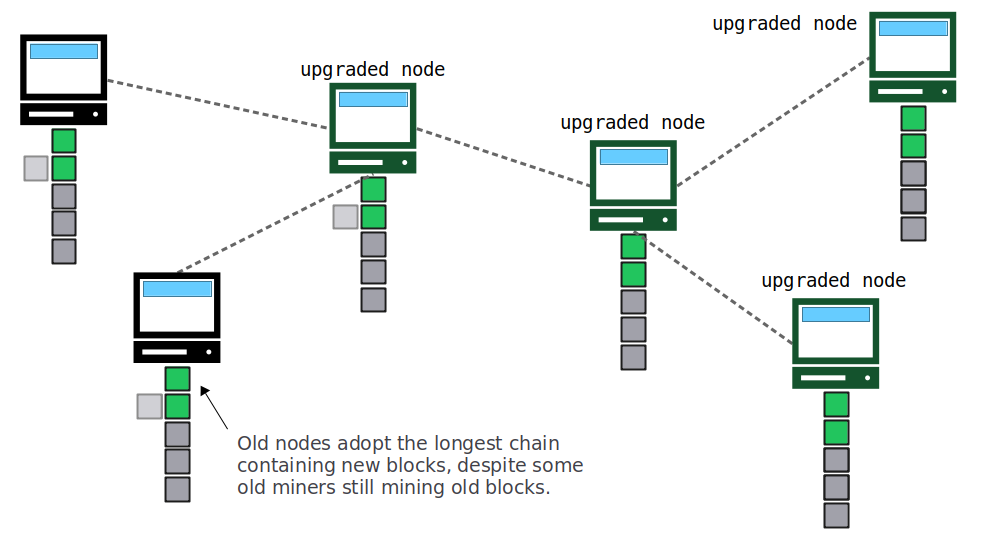
So even if a minority of old miners continue to build the blockchain with old blocks, they will not be able to compete with the speed at which the new blocks are being mined by the upgraded miners, so old nodes will adopt the same version of the blockchain as the upgraded nodes.
Risks
What are the risks of a soft fork?
The main risk with a soft fork is if you do not get a majority of the miners to upgrade.
This will result in the blockchain splitting in two, as a majority of old miners will continue to mine old blocks that are incompatible with the new version of the software.
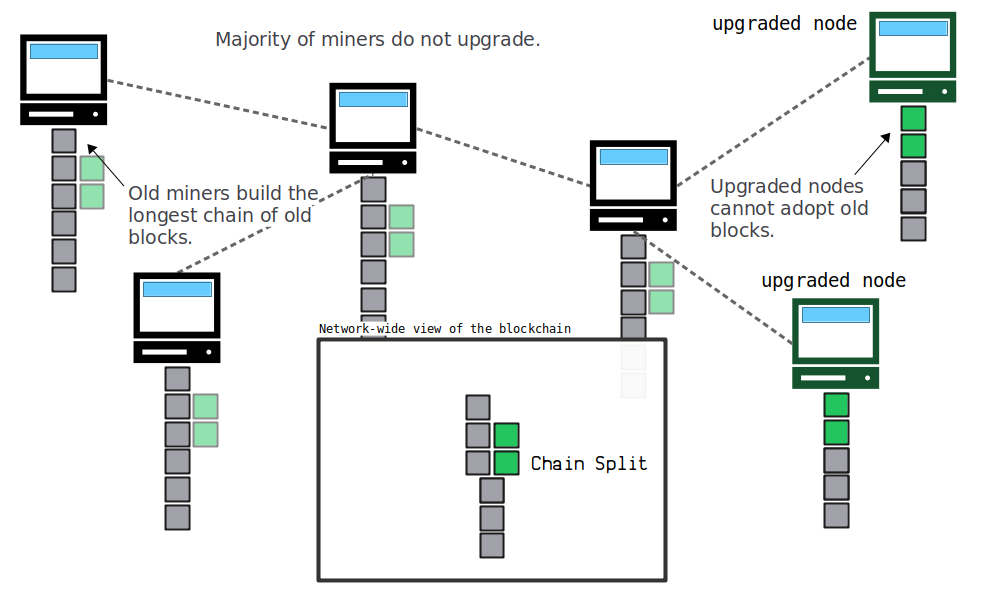
And because old blocks form the longest available chain, old nodes will adopt this as their blockchain. However, the upgraded nodes will reject these old blocks (because those blocks are now invalid according to their upgraded rules), and they will adopt the longest available chain containing only the new blocks instead.
So once again, just like in a hard fork, you have two parallel versions of the blockchain; one containing old blocks, and another containing new blocks.
However, unlike a hard fork where the two chains can never converge, this chain split can be resolved by getting more mining power on to the new chain. If upgraded miners are able to build the longest chain, old nodes will perform a chain reorganisation to adopt the blockchain made out of the new blocks.
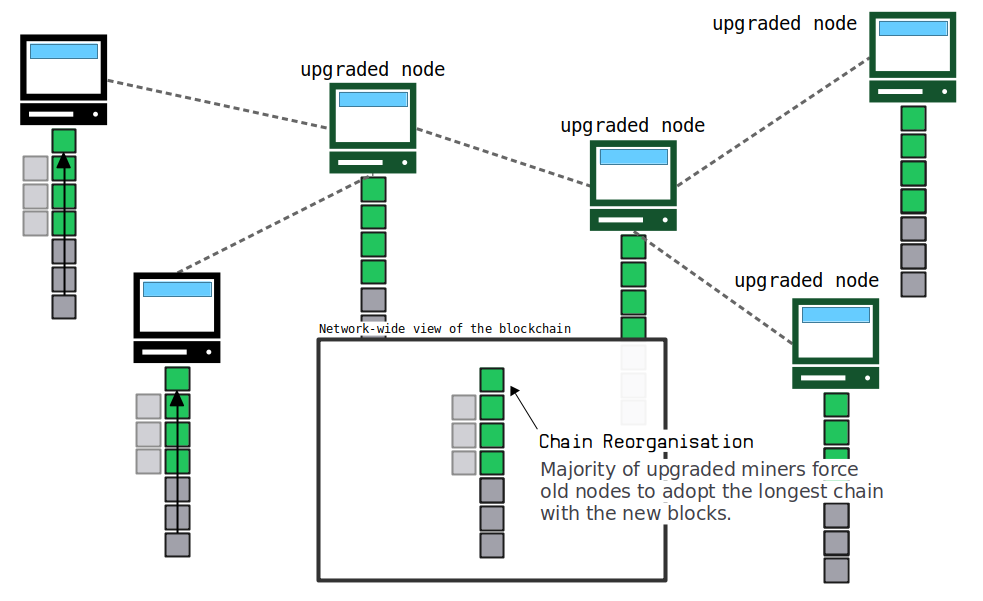
So by getting a majority of miners to upgrade, you "encourage" everyone on the network to keep up to date with the same version of the blockchain.
Compromises
What is the downside to a soft fork?
The biggest downside to soft forks is they tend to make the software more complex (Segregated Witness is a prime example).
It would be easier to make direct upgrades to the software through hard forks. However, a hard-forking change is undesirable due to the greater risk of a chain split (and having to force everyone to upgrade), so most upgrades are made through soft forks instead.
As a result, the fact that you have to keep the changes compatible with the old software means you have to make more technical workarounds, and this makes the software more complex than if you had the freedom to make changes that would be incompatible with old nodes.
In short:
- A hard fork allows you to directly replace rules and code.
- A soft fork involves adding more code to account for new rules.
Examples
Have there been any soft forks in bitcoin?
All major upgrades to Bitcoin so far have been deployed as soft forks.
Here are some examples, including a summary of the new restrictions they introduced:
1. BIP 16: Pay to Script Hash
Problem
There was no convenient way to get other people to use custom locks of your choice when sending you bitcoins.
Restriction
A specific ScriptPubKey pattern now has additional validation rules (see P2SH).
So whereas the locking script pattern OP_HASH160 OP_PUSHBYTES_20 digest OP_EQUAL previously only required you to provide some data that hashed to digest to unlock it, you now needed to provide some data in the form of a custom locking script that hashed to digest and could be evaluated and unlocked in a second step of execution.
In other words, there were additional rules on how a specific locking script could be unlocked.
2. BIP 30: Duplicate transactions
Problem
It was not thought to be possible that you could have duplicate transactions in Bitcoin.
However, coinbase transactions in different blocks could have the same TXID, allowing for duplicate transactions in the blockchain. This would also allow for further duplicate transactions to be created later on.
Restriction
Blocks are not allowed to contain a transaction with a TXID that matches an earlier, not-fully-spent transaction in the same chain.
3. BIP 34: Block v2, Height in Coinbase
Problem
Even after the introduction of BIP 30 (see above), it was still possible for miners to construct duplicate coinbase transactions in different blocks.
Restriction
A coinbase transactions must contain the block height as the first field in the ScriptSig. This ensures that every coinbase transaction will be unique (and therefore have a unique TXID).
Any coinbase transaction that did not contain the height of the current block would now be invalid.
4. BIP 65: OP_CHECKLOCKTIMEVERIFY
Problem
There was no mechanism to make it impossible to spend a specific transaction output until a future date.
Restriction
The OP_NOP2 opcode was repurposed for OP_CHECKLOCKTIMEVERIFY instead.
Therefore, the OP_NOP2 opcode could no longer "did nothing" and could not be used in the same way as it was previously.
5. BIP 66: Strict DER signatures
Problem
Lack of consistency with the encoding of signatures in transactions due to a reliance on the OpenSSL library.
Restriction
Restrict signatures to follow a single encoding format. This makes it easier for implementations of Bitcoin to not have to rely on OpenSSL as a dependency.
6. BIP 141: Segregated Witness
Problem
The TXID could be modified after sending a transaction in to the network, which meant you couldn't depend on the TXID for referencing the transaction later on.
This was because the TXID was made including the signatures inside the transaction, and these signatures could be modified after they are created (yet still remain valid).
Restriction
Two new patterns of ScriptPubKey (P2WPKH, P2WSH) that were once spendable by anyone are now only spendable under certain conditions.
This allows for a new transaction data structure, where the signatures sit at the end of the transaction data (in a new witness area) and are not included in the creation of the TXID.
Segregated Witness also allowed for a block size increase. This was made possible by not sending the new witness section of transactions (containing the signatures) to the old nodes. The old nodes would see these outputs as spendable by anyone anyway, so the signatures were not required for the transactions to be considered valid.
7. BIP 341: Taproot
Problem
A ScriptPubKey reveals all of its spending conditions inside the transaction data. These can be complex and large, and displaying all the spending conditions isn't good for privacy.
Restriction
A new pattern of ScriptPubKey (P2TR) that was once spendable by anyone is now only spendable under certain conditions. This allows for a new locking and unlocking mechanism that only reveals one spending condition (and not all the other spending conditions that could have existed for the lock).
Deployment
How are soft forks deployed?
The goal of a successful soft fork is to get a majority of miners to agree to the upgrade.
So before the soft-forking change is activated, miners are asked to signal their readiness beforehand. Miners can signal readiness by setting a specific bit in the version field of the block header.
For example:
00100000 00000000 00000000 00000001 = Bit 0 = CHECKSEQUENCEVERIFY (BIP 65)
00100000 00000000 00000000 00000010 = Bit 1 = Segregated Witness (BIP 141)
00100000 00000000 00000000 00000100 = Bit 2 = Taproot (BIP 341)
When 90-95% of miners are signalling that they are in agreement with the upgrade within a target adjustment period (and that they will mine the new blocks with the new rules), the soft fork gets "locked in", and at a specific block height the miners will begin to mine the new blocks.
- The first 3 bits in the version must be set to
001to be able to signal readiness for soft forks. - Earlier soft forks (e.g. BIP 16) were deployed before this specific signalling system was set up.
- Soft forks usually requires 95% of miners to signal for activation, but with Taproot this was modified to only require 90%.
Summary
A soft fork is an upgrade to the Bitcoin software that is compatible with old versions of the software. It maintains this compatibility by restricting the rules around valid blocks/transactions, as opposed to relaxing them like in a hard fork.
The primary benefit of a soft fork is that all nodes on the network can keep up to date with the blockchain even if they do not upgrade.
The key to a successful soft fork is to get a majority of miners to upgrade to the new version of the software. By doing so, miners will have the power to build the longest chain of new blocks/transactions, and old nodes will naturally adopt this longest chain containing the upgraded blocks.
All upgrades to the Bitcoin software so far have been made via soft forks.